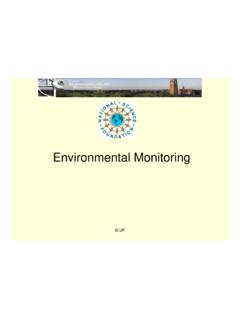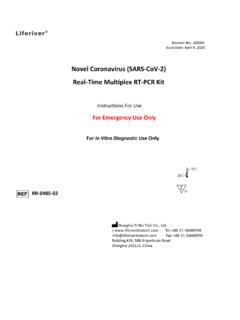Transcription of Hand Hygiene: Why, How & When? - WHO | World Health ...
1 Hand Hygiene: Why, How & When? WHY? Thousands of people die every day around the World from infections acquired while receiving Health care. Hands are the main pathways of germ transmission during Health care. Hand hygiene is therefore the most important measure to avoid the transmission of harmful germs and prevent Health care-associated infections. This brochure explains how and when to practice hand Any Health -care worker, caregiver or person involved in direct or indirect patient care needs to be concerned about hand hygiene and should be able to perform it correctly and at the right clean your hands by rubbing them with an alcohol-based formulation, as the preferred mean for routine hygienic hand antisepsis if hands are not visibly soiled.
2 It is faster, more effective, and better tolerated by your hands than washing with soap and water. Wash your hands with soap and water when hands are visibly dirty or visibly soiled with blood or other body fluids or after using the toilet. If exposure to potential spore-forming pathogens is strongly suspected or proven, including outbreaks of Clostridium difficile, hand washing with soap and water is the preferred 1 OF 7 WHO acknowledges the H pitaux Universitaires de Gen ve (HUG), in particular the members of the Infection Control Programme, for their active participation in developing this reasonable precautions have been taken by the World Health Organization to verify the information contained in this , the published material is being distributed without warranty of any kind, either expressed or implied.
3 The responsibility for the interpretation and use of the material lies with the reader. In no event shall the World Health Organization be liable for damages arising from its August 2009 HAND HYGIENE: WHY, HOW & WHEN? WHO acknowledges the H pitaux Universitaires de Gen ve (HUG), in particular the members of the Infection Control Programme, for their active participation in developing this reasonable precautions have been taken by the World Health Organization to verify the information contained in this , the published material is being distributed without warranty of any kind, either expressed or implied. The responsibility for the interpretation and use of the material lies with the reader. In no event shall the World Health Organization be liable for damages arising from its 2 OF 7 RUB HANDS FOR HAND HYGIENE!
4 WASH HANDS WHEN VISIBLY SOILEDA pply a palmful of the product in a cupped hand, covering all surfaces;Rub hands palm to palm;Right palm over left dorsum with interlaced fingers and vice versa;Palm to palm with fingers interlaced;Backs of fingers to opposing palms with fingers interlocked;Rotational rubbing of left thumb clasped in right palm and vice versa;Rotational rubbing, backwards and forwards with clasped fingers of right hand in left palm and vice versa;Once dry, your hands are safe. Duration of the entire procedure: 20-30 seconds1a1b2345678 HOW TO HANDRUB?HAND HYGIENE: WHY, HOW & WHEN? WHO acknowledges the H pitaux Universitaires de Gen ve (HUG), in particular the members of the Infection Control Programme, for their active participation in developing this reasonable precautions have been taken by the World Health Organization to verify the information contained in this , the published material is being distributed without warranty of any kind, either expressed or implied.
5 The responsibility for the interpretation and use of the material lies with the reader. In no event shall the World Health Organization be liable for damages arising from its care Take care of your hands by regularly using a protective hand cream or lotion, at least daily. Do not routinely wash hands with soap and water immediately before or after using an alcohol-based handrub. Do not use hot water to rinse your hands. After handrubbing or handwashing, let your hands dry completely before putting on remember Do not wear artificial fingernails or extenders when in direct contact with patients. Keep natural nails HANDS WHEN VISIBLY SOILED! OTHERWISE, USE HANDRUB Duration of the entire procedure: 40-60 seconds01234567891011 Rub hands palm to palm;Apply enough soap to cover all hand surfaces;Wet hands with water;Right palm over left dorsum with interlaced fingers and vice versa;Palm to palm with fingers interlaced;Backs of fingers to opposing palms with fingers interlocked;Rotational rubbing of left thumb clasped in right palm and vice versa;Rotational rubbing, backwards and forwards with clasped fingers of right hand in left palm and vice versa;Rinse hands with water;Your hands are now towel to turn off faucet;Dry hands thoroughlywith a single use towel;HOW TO HANDWASH?
6 PAGE 3 OF 7 HAND HYGIENE: WHY, HOW & WHEN? WHO acknowledges the H pitaux Universitaires de Gen ve (HUG), in particular the members of the Infection Control Programme, for their active participation in developing this reasonable precautions have been taken by the World Health Organization to verify the information contained in this , the published material is being distributed without warranty of any kind, either expressed or implied. The responsibility for the interpretation and use of the material lies with the reader. In no event shall the World Health Organization be liable for damages arising from its 5 MOMENTS FOR HAND HYGIENE*PAGE 4 OF 73 RISKFLUID EXPOSUREAFTER BODY1 BEFORETOUCHINGA PATIENTCRITICAL SITE WITHINFECTIOUS RISKFOR THE PATIENTCRITICAL SITEWITH BODY FLUIDEXPOSURE RISK4 AFTERTOUCHINGA PATIENT5 AFTERTOUCHING PATIENTSURROUNDINGS2 BEFORE clean /ASEPTICPROCEDURE*NOTE: Hand hygiene must be performed in all indications described regardless of whether gloves are used or HYGIENE: WHY, HOW & WHEN?
7 WHO acknowledges the H pitaux Universitaires de Gen ve (HUG), in particular the members of the Infection Control Programme, for their active participation in developing this reasonable precautions have been taken by the World Health Organization to verify the information contained in this , the published material is being distributed without warranty of any kind, either expressed or implied. The responsibility for the interpretation and use of the material lies with the reader. In no event shall the World Health Organization be liable for damages arising from its use. Before touching a patientWHY? To protect the patient against colonization and, in some cases, against exogenous infection, by harmful germs carried on your handsWHEN?
8 clean your hands before touching a patient when approaching him/her*Situations when Moment 1 applies:a) Before shaking hands, before stroking a child s foreheadb) Before assisting a patient in personal care activities: to move, to take a bath, to eat, to get dressed, etcc) Before delivering care and other non-invasive treatment: applying oxygen mask, giving a massagec) Before performing a physical non-invasive examination: taking pulse, blood pressure, chest auscultation, recording ECG Before clean / aseptic procedureWHY? To protect the patient against infection with harmful germs, including his/her own germs, entering his/her bodyWHEN? clean your hands immediately before accessing a critical site with infectious risk for the patient ( a mucous membrane, non-intact skin, an invasive medical device)*Situations when Moment 2 applies.
9 A) Before brushing the patient s teeth, instilling eye drops, performing a digital vaginal or rectal examination, examining mouth, nose, ear with or without an instrument, inserting a suppository / pessary, suctioning mucous b) Before dressing a wound with or without instrument, applying ointment on vesicle, making a percutaneous injection / puncturec) Before inserting an invasive medical device (nasal cannula, nasogastric tube, endotracheal tube, urinary probe, percutaneous catheter, drainage), disrupting / opening any circuit of an invasive medical device (for food, medication, draining, suctioning, monitoring purposes)d) Before preparing food, medications, pharmaceutical products, sterile material After body fluid exposure riskWHY?
10 To protect you from colonization or infection with patient s harmful germs and to protect the Health -care environment from germ spreadWHEN? clean your hands as soon as the task involving an exposure risk to body fluids has ended (and after glove removal)*Situations when Moment 3 applies:a) When the contact with a mucous membrane and with non-intact skin endsb) After a percutaneous injection or puncture; after inserting an invasive medical device (vascular access, catheter, tube, drain, etc); after disrupting and opening an invasive circuitc) After removing an invasive medical deviced) After removing any form of material offering protection (napkin, dressing, gauze, sanitary towel, etc)e) After handling a sample containing organic matter, after clearing excreta and any other body fluid, after cleaning any contaminated surface and soiled material (soiled bed linen, dentures, instruments, urinal, bedpan, lavatories, etc) After touching a patientWHY?















